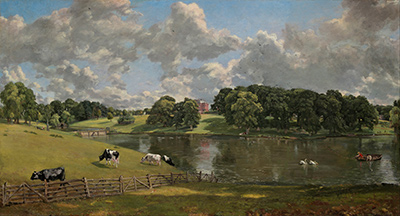Wivenhoe Park is one of John Constable’s most successful works. The oil on canvas painting depicts a lovely summer day on the vast parklands.
Even with the cloudy skies, the piece illustrates a beautiful day where livestock is out grazing and fishermen are in the lake casting their nets. The trees give picturesque scenery and inviting shades that offer relief from the bright sunlight.
Wivenhoe Park captures the imagination of the artist and brings his creativity to life in a simple manner. True to his style of painting, Constable used nature to compose the picture. He believed in painting from reality as opposed to creating pieces from imagination. From the rolling countryside to the green tree line, the landscape painting oozes serenity that goes beyond the canvas.
Major General Francis Slater-Rebow, the owner of Wivenhoe Park and one of Constable’s first patrons, commissioned the painting. There were several others commissioned by Slater-Rebow.
This particular piece also features Mary Rebow, the generals’ daughter, driving a horse cart up the slope with a friend (far left). Wivenhoe Park was an epitome of rural England, which was the inspiration for Constable’s, paintings. The lush countryside, livestock and farming activities offered the perfect features for the artist to work with. He painted the park as a relaxing environment where one could wind down a long day and functional with several tasks taking place.
John Constable’s attention to detail can be felt in each brushstroke on this piece. It is evident in the birds that fly just above the trees across the blue and grey skies and the reflection of the main house in the clear lake.
Constable draws attention to every aspect of the landscape, allowing the spectator to feel close to the surroundings. He emphasises the peaceful coexistence of man and nature by showing swans swimming calmly in the lake as two fishermen in a boat go about their duties. One can feel the flowers blooming just below the wooden fence and imagine the sound of hoes hitting the ground as the workers toil near the lake.
Wivenhoe Park was done in September 1816 and earned Constable enough money to marry. Before that, the English romantic painter had not enjoyed a lot of accomplishment from his work.
In fact, his lack of commercial success was the reason he had not been able to wed Mary Bickle, his longtime love. Mary’s father believed John to be of an inferior class and threatened to disinherit his daughter if she went ahead with the marriage.
Constable received significant recognition in France with his revolutionary artwork, but he never considered leaving England. His works inspired the Barbizon School, 19th-century French Impressionists and contemporaries like Delacroix and Gericault. The artist did a lot of observational studies of landscapes in an effort to give more authenticity to his paintings. Constable based most of his works on his homeland in the Sothern England countryside. Currently, he is considered one of the greatest landscape artists in English history. Some of his other famous works include Dedham Vale, The Hay Wain and the Leaping Horse.




